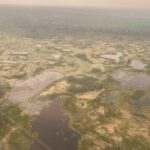Higher temperatures in the springtime could prompt larger, more devastating fires in Canada’s boreal forests, a study finds.
The region, which stretches across northern Canada, could be at risk if the change follows a similar climate scenario that happened more than 3,000 years ago, researchers concluded in a study published yesterday in the Proceedings of the National Academy of Sciences.
The researchers used sedimentary charcoal records from lakes around the North American boreal forests across the provinces of Manitoba, Ontario, Quebec, and Newfoundland and Labrador. They found that over the past 7,000 years, wildfires have steadily increased in size.
About 3,000 years ago, during the middle Holocene, a turning point occurred. A period in which many small wildfires would ignite across the forests was replaced by a landscape in which fewer, but larger, fires reigned.
Comparing their findings with climate data from the Holocene, the scientists were able to link higher springtime temperatures and bigger fires.






